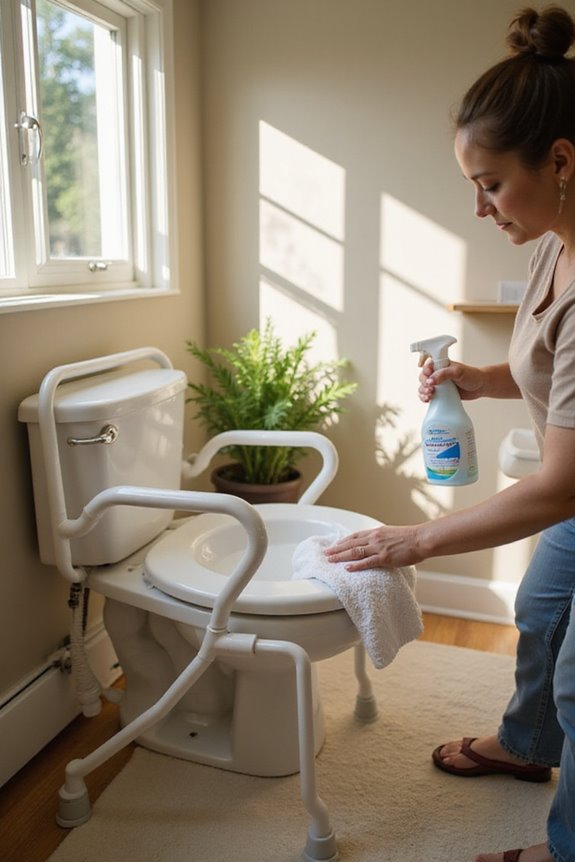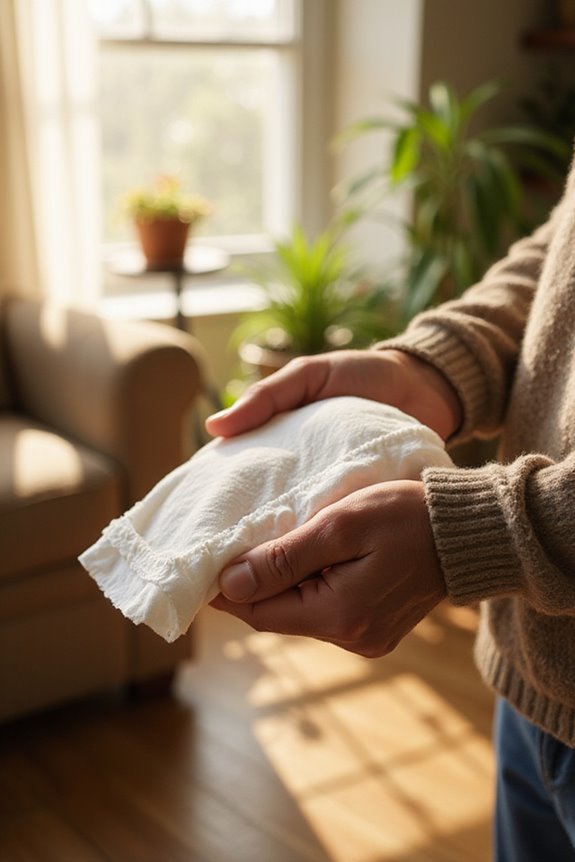Cleaning and maintaining commode chairs is essential for hygiene and safety. Daily tasks include using mild detergent with warm water to wipe surfaces, focusing on high-contact areas. Prevent odors by regularly emptying waste and utilizing absorbent pads. Disinfect with EPA-registered agents, allowing sufficient contact time. Conduct routine inspections for wear and lubricate moving parts as necessary. Proper disposal of waste involves wearing gloves and sealing liners securely. Further insights into maintenance procedures are available in the following sections.
Key Takeaways
- Regularly clean commode chairs with mild detergent and disinfectant, focusing on high-contact areas for hygiene.
- Empty waste receptacles frequently to prevent odors and maintain cleanliness.
- Use EPA-registered disinfectants, allowing adequate contact time for effective sanitization.
- Perform routine inspections and lubricate moving parts to ensure safe operation and longevity.
- Follow local disposal guidelines for waste and liners, practicing hygiene by wearing gloves and washing hands afterward.
Daily Cleaning Procedures
Daily cleaning procedures for commode chairs are crucial to maintain hygiene and assure user safety. Proper supply organization is essential for effective cleaning techniques.
Preparation for Cleaning:
- Gather mild detergent, warm water, soft cloths, disinfectant, and gloves.
- Review manufacturer guidelines to select appropriate cleaning agents.
- Prepare a cleaning solution by mixing detergent with warm water.
Cleaning Process:
- Detach seat, armrests, and backrest for thorough cleaning.
- Wipe all surfaces, focusing on high-contact areas.
- Clean the receptacle with a brush and disinfectant.
Disinfection:
- Apply an approved disinfectant and allow it to sit for the recommended time.
- Inspect for residue and verify surfaces are dry before reassembly.
Routine maintenance guarantees maximum hygiene and user safety.
Preventing Odor and Stains
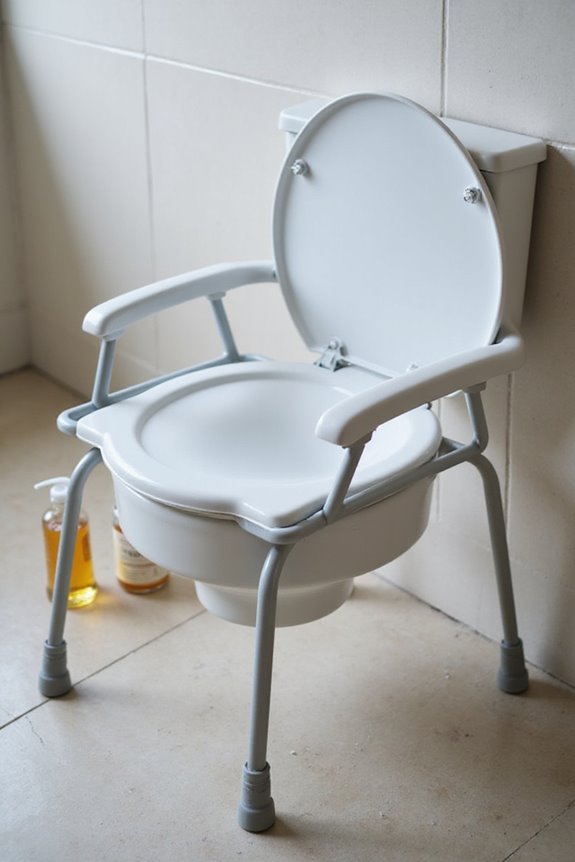
Preventing odor and stains in commode chairs is essential for maintaining a hygienic environment and ensuring user comfort. Effective odor control can be achieved through several strategies:
- Regular Emptying: Prompt disposal of waste prevents accumulation and associated odors.
- Ventilation: Open windows or use fans for enhanced air circulation.
- Odor Absorbents: Utilize absorbent pads to gel liquids and lock in odors.
- Air Purifiers & Charcoal: Implement air purifiers and activated charcoal to neutralize odors.
For stain removal, consider the following:
- Baking Soda: Use as a gentle abrasive for cleaning.
- Regular Maintenance: Clean components frequently to avoid stain buildup.
- Proper Storage: Keep commodes in dry, clean areas to deter mold.
Combining these practices promotes a clean, welcoming space.
Disinfection and Sanitization
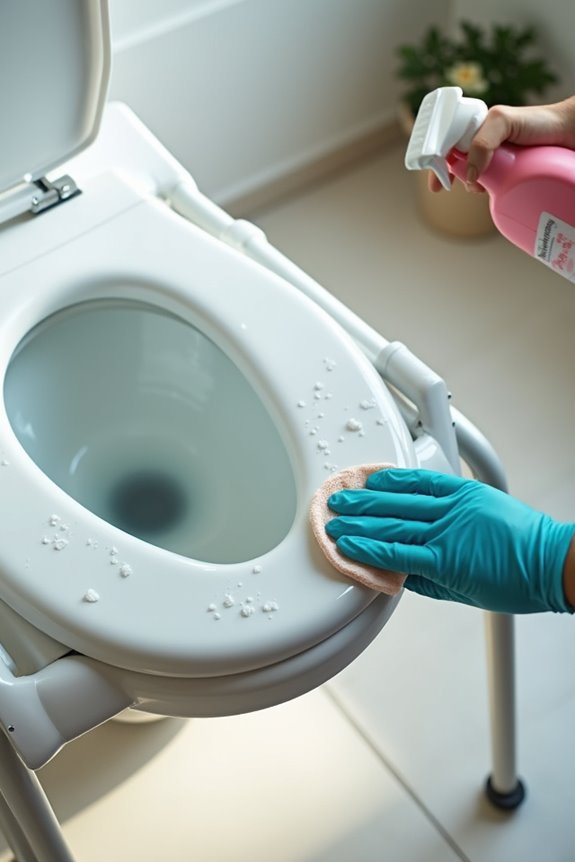
Disinfection and sanitization of commode chairs are essential for ensuring user safety and maintaining a hygienic environment.
Disinfectant Selection
Utilize EPA-registered disinfectants that are safe for both plastic and metal surfaces. Avoid harsh chemicals that could damage materials, and always adhere to manufacturer guidelines. The selected disinfectant must be effective against common pathogens, as indicated on the label.
Application and Contact Time****
Liberally spray or wipe all surfaces, focusing on the seat, armrests, and handles. The disinfectant should remain on these surfaces for the prescribed contact time, typically 10 minutes or more. After this period, wipe down surfaces with a warm, damp cloth to remove any residue. Immediate cleaning is necessary for visible soil or spills to maintain peak hygiene standards.
Routine Maintenance
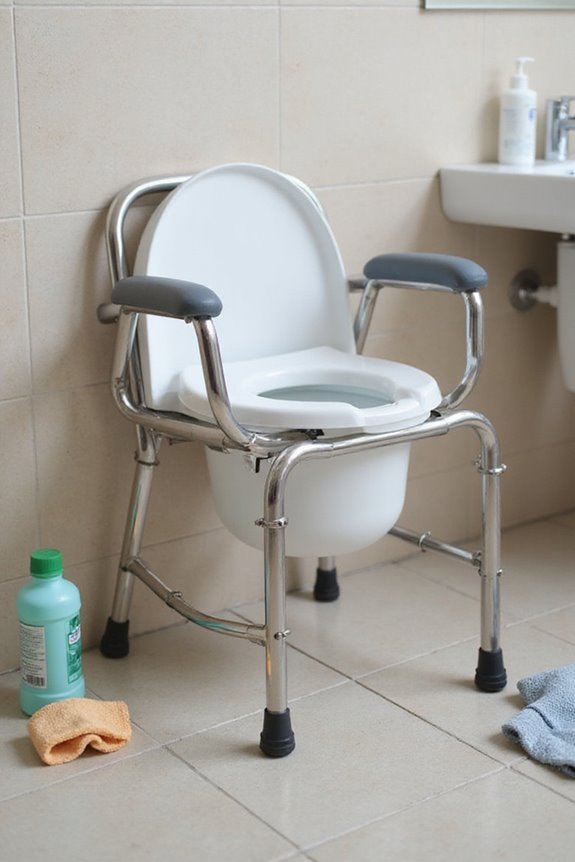
Routine maintenance of commode chairs is essential for ensuring their functionality and longevity.
Routine Inspections
Regular checks are necessary to identify wear or defects in the chair’s frame and components. Inspect adjustable legs and rubber stoppers for damage, ensuring stability.
Lubrication Schedules
Moving parts, such as hinges and wheels, require periodic lubrication with silicone-based products. This prevents rust and promotes smooth operation.
Surface Cleaning
Utilize a soft cloth with mild soap and water for thorough cleaning. Avoid abrasive agents to prevent damage.
Deep Maintenance
Disassemble the chair occasionally to clean hidden areas, tightening screws as needed. Additionally, consider the weight capacity of the chair during maintenance to ensure it continues to support users safely.
Incorporating these practices fosters a sense of community and responsibility, enhancing user confidence in maintaining a safe, functional environment.
Safe Disposal and Hygiene Practices
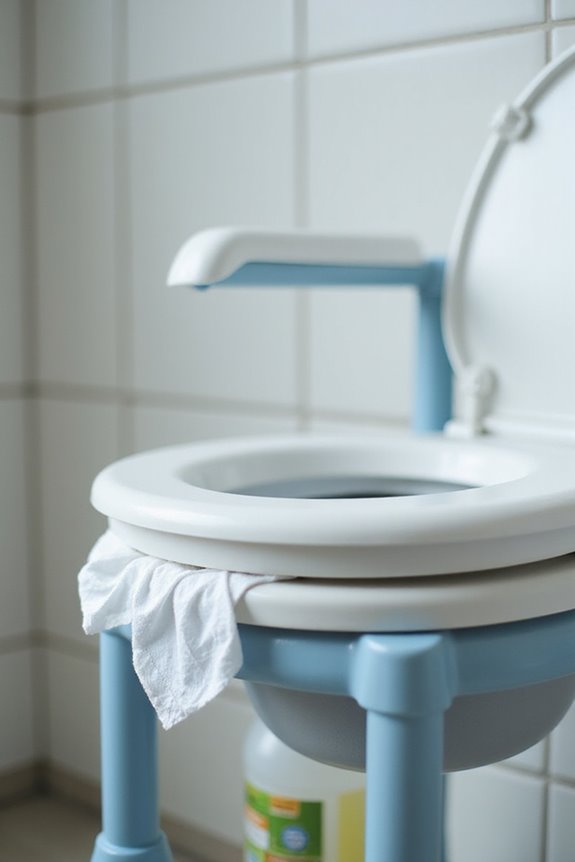
Safe disposal and hygiene practices are critical for maintaining health and sanitation in environments that utilize commode chairs.
Understanding Local Disposal Regulations****
- Verify disposal guidelines with local waste management.
- Determine if used liners can go in household trash or require special handling as biohazardous waste.
- Stay informed on local regulations to guarantee compliance.
Safe Liner Removal and Sealing
- Wear disposable gloves during the process.
- Carefully remove liners, sealing them tightly to prevent leaks.
- Dispose of sealed liners in designated containers.
Hygiene Practices During Disposal
- Wash hands immediately after handling waste.
- Clean and disinfect surfaces in contact with the liners.
Adhering to these disposal regulations and hygiene standards fosters a safer environment for all users.
Manufacturer and User Guidelines
- Routine Inspection Schedules: Regular checks for wear and damage.
- Deep Cleaning Protocols: Periodic disassembly for thorough cleaning.
- Lubrication: Use silicone-based lubricants on moving parts.
For users, there are defined user responsibilities:
- Daily Cleaning Routine: Empty and rinse the commode bucket each day.
- Disinfectant Use: Apply appropriate disinfectants to kill germs.
- Odor Control: Guarantee proper ventilation in the room.
Following these guidelines not only promotes hygiene but also enhances safety, guaranteeing that commode chairs remain functional and reliable for all users.
Tips for Caregiver Training
Effective caregiver training is a vital component in ensuring the proper care and maintenance of commode chairs. Caregivers must be equipped with essential skills and knowledge, including:
- Caregiver Communication: Clear communication with users enhances comfort and trust, fostering a supportive environment.
- Transfer Techniques: Training on safe transfer methods minimizes fall risks, ensuring user safety.
- Proper Use: Caregivers should be instructed on the correct height and positioning of the commode for user comfort.
- Equipment Maintenance: Regular inspections for wear and tear, alongside prompt reporting of issues, are essential for safety.
Frequently Asked Questions
How Often Should I Replace the Commode Chair?
Determining a replacement schedule hinges on chair materials and usage. While some endure years, others falter quickly. Regular assessments reveal wear, guiding timely replacements that guarantee safety and comfort for all who rely on them.
Can I Use Vinegar for Cleaning the Commode?
Vinegar offers various cleaning benefits, including stain removal and antibacterial properties. As a cost-effective cleaning alternative, it provides a safer option for households, promoting a sense of community through environmentally friendly practices while ensuring cleanliness.
What Are the Signs of Wear in a Commode Chair?
During a commode chair inspection, various wear indicators emerge, such as visible cracks, instability in the frame, persistent odors, and compromised surfaces, all signaling the need for attention to guarantee continued safety and comfort for users.
How Can I Prevent Rust on Metal Components?
To prevent rust on metal components, effective rust prevention strategies include proper storage, selecting rust-resistant materials, applying protective coatings, and regular metal maintenance. Consistent inspections and timely repairs guarantee longevity and enhance overall durability in various environments.
Is It Safe to Use Bleach on Plastic Parts?
Ironically, while bleach safety promises cleanliness, its harshness on plastics reveals a hidden truth. For effective plastic cleaning, diluted solutions and alternatives provide better results, ensuring longevity and preventing the degradation that frequent bleach use invites.

